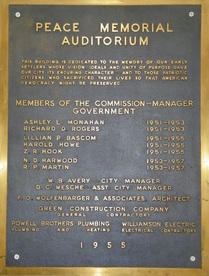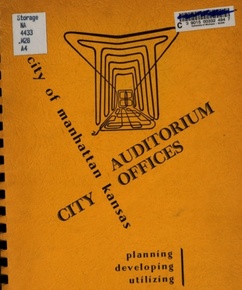Peace Memorial Auditorium History
In 2012, Manhattan's City Commission began discussing how to provide the Parks and Recreation Department with improved office space, eventually settling on a plan that would have placed the department within Peace Memorial Auditorium, removed the vintage fixed seating, and also removed the performance stage and replaced it with practice-sized basketball courts. Missing from these early City Commission discussions was information about Peace Memorial Auditorium's role as a living memorial to honor the 2,610 Riley Countians who had served in World War II and the 101 servicemen who lost their lives in the war. As the years had passed, our community had forgotten about the auditorium's role as a memorial. Fortunately, there were a few citizens who remembered and brought to light the strong community-wide effort that had occurred in 1946 when citizens approved an $800,000 bond to construct Peace Memorial Auditorium.
Through advocacy efforts, citizens were able to convince the City Commission to change course. New offices for the Parks and Recreation Department will be constructed as a new addition to City Hall; the auditorium will receive air-conditioning, improved heating, and a lift for handicapped access to the stage; and the public has been charged with raising the funds for additional improvements to Peace Memorial Auditorium. Needed improvements include an improved electrical system, stage lighting, sound system, curtains and rigging, refurbishing the stage floor, refurbishing the vintage fixed seating, and providing a plaque or other commemoration to honor the 101 Riley Countians who lost their lives in World War II.
Below is additional information about Peace Memorial Auditorium.
Through advocacy efforts, citizens were able to convince the City Commission to change course. New offices for the Parks and Recreation Department will be constructed as a new addition to City Hall; the auditorium will receive air-conditioning, improved heating, and a lift for handicapped access to the stage; and the public has been charged with raising the funds for additional improvements to Peace Memorial Auditorium. Needed improvements include an improved electrical system, stage lighting, sound system, curtains and rigging, refurbishing the stage floor, refurbishing the vintage fixed seating, and providing a plaque or other commemoration to honor the 101 Riley Countians who lost their lives in World War II.
Below is additional information about Peace Memorial Auditorium.
|
"Living" Type of War Memorial Has Edge in Nation-Wide Survey of Plans
The Kansas City Times, Sept. 12, 1945 Peace Memorial Auditorium is a "living memorial." The 1945 article explains the philosophy of "living memorials" and the desire to create useful memorials. |
"A Two-Way Opportunity," Manhattan Mercury-Chronicle editorial, Oct. 30, 1946
"The 101 who did not come back, whose bodies lie in rest over the world, are still with us spiritually. Granite shafts or temples of memory have their place, but these 101, we believe, would want something more than that . . . " Click the button to read the full editorial that encouraged voters to support the ballot initiative to construct a memorial auditorium. |
"Gold Star" refers to a service member who was killed in combat operations.
Additional Information
The Friends of Peace Memorial Auditorium began as an offshoot of the Manhattan/Riley County Preservation Alliance. The M/RCPA's web site has additional information about the history of the process, and we encourage you to visit its web site.


